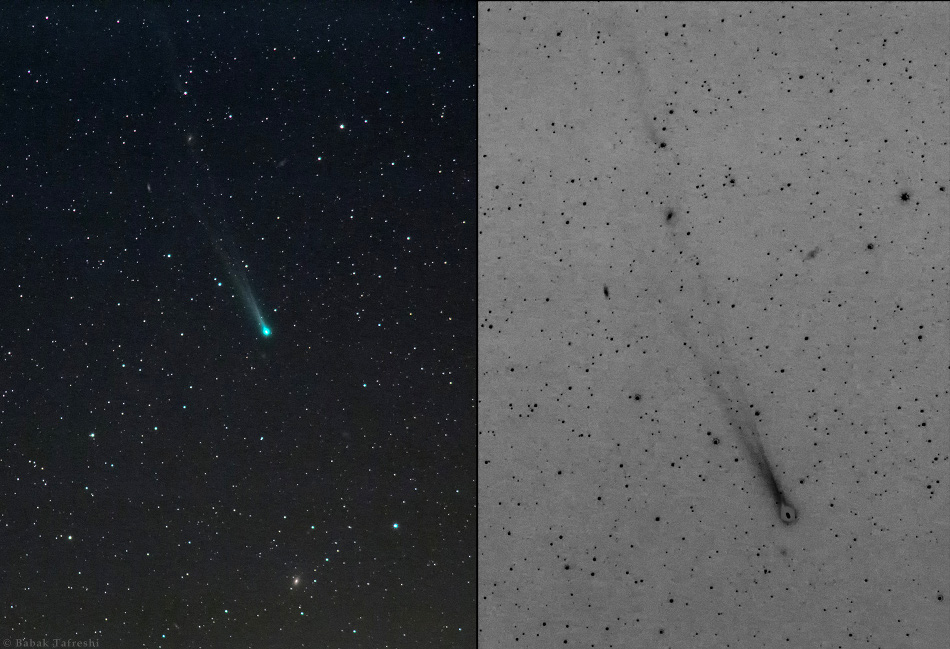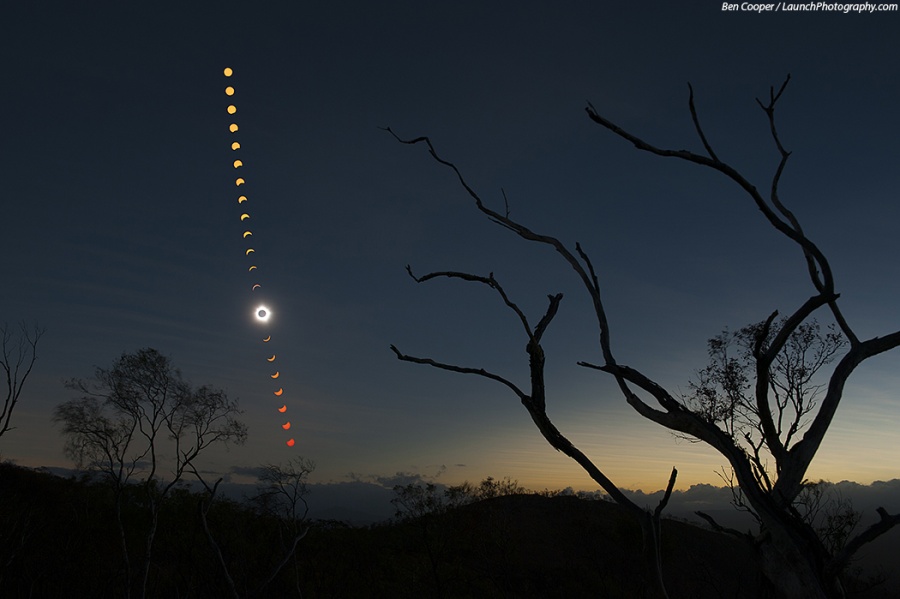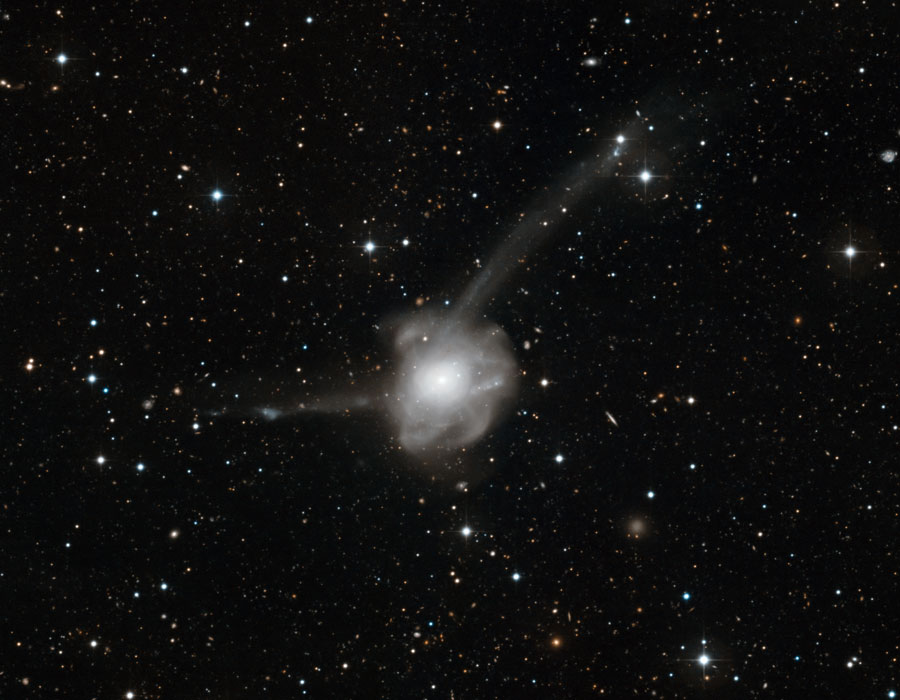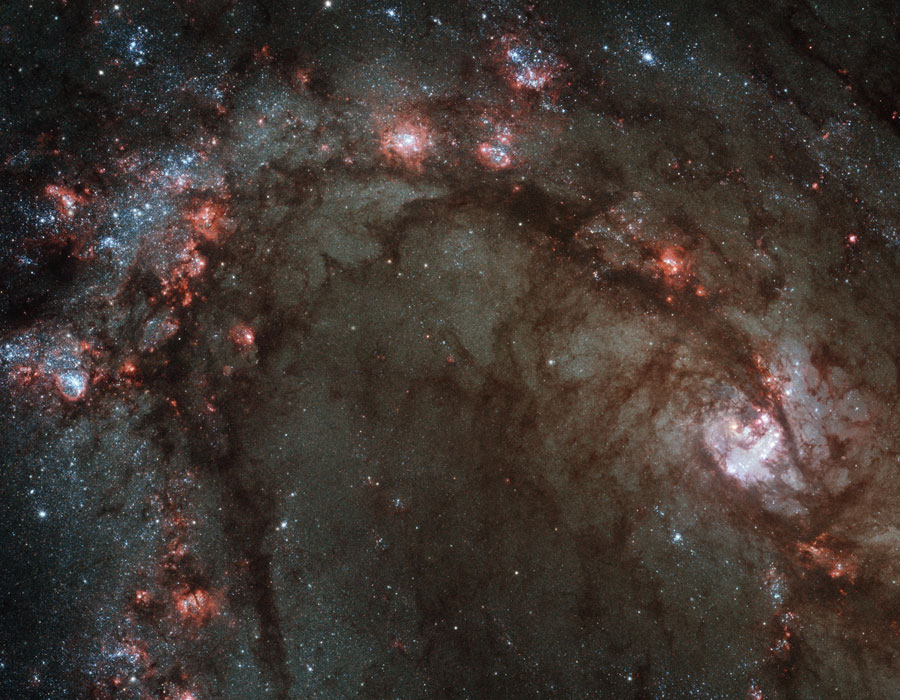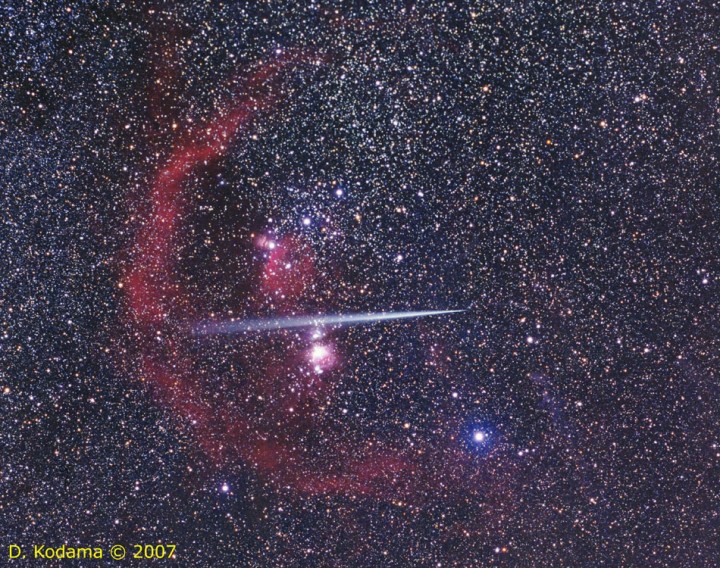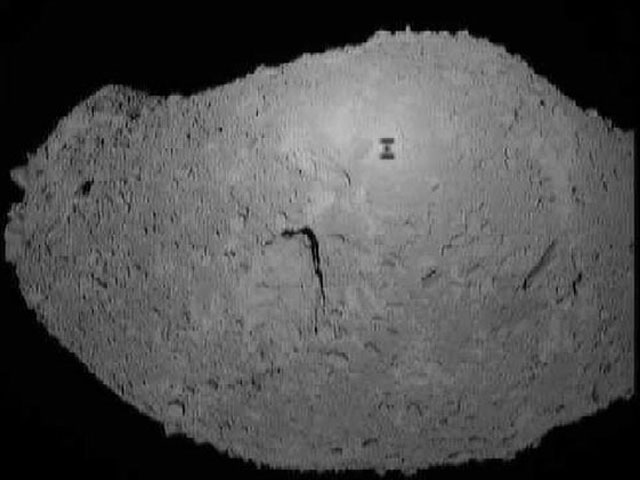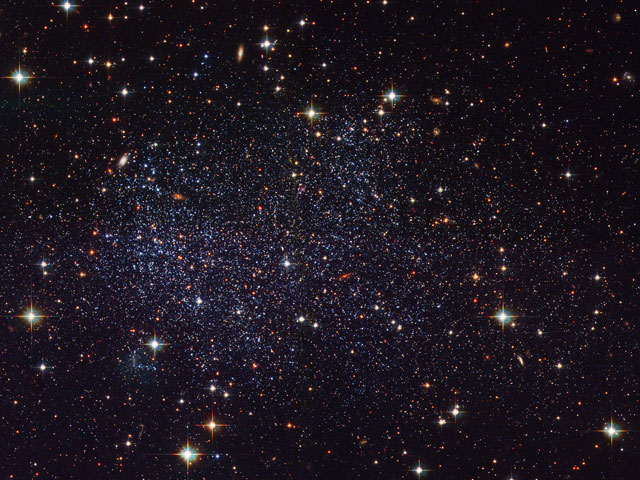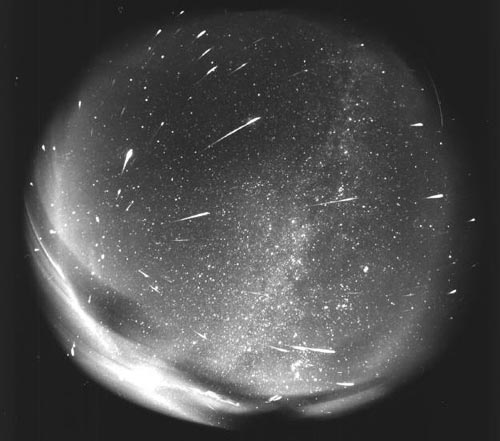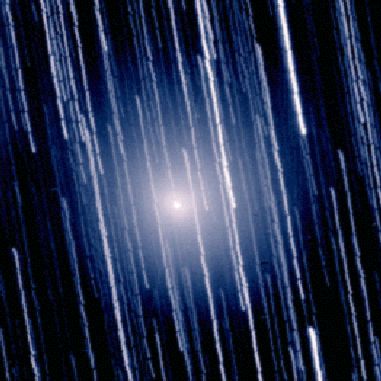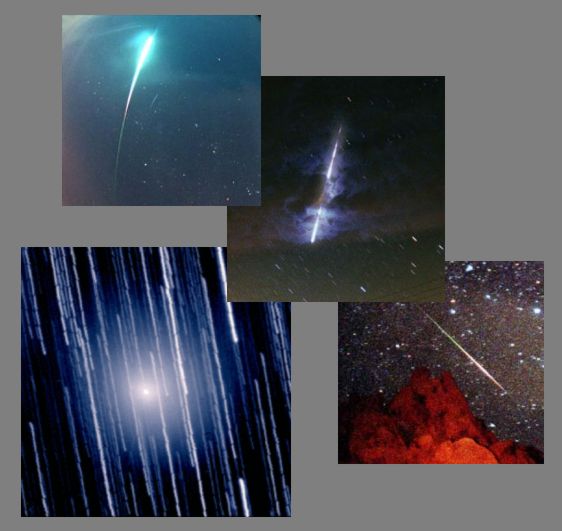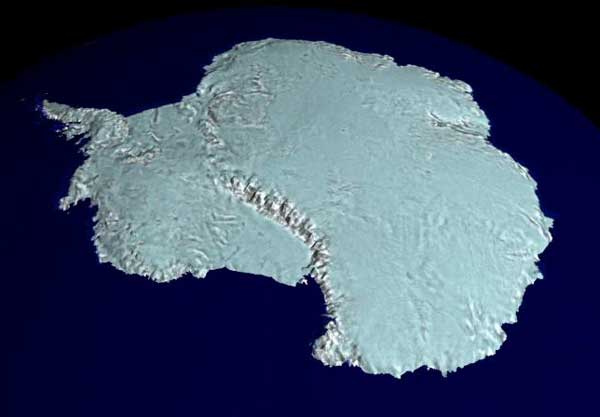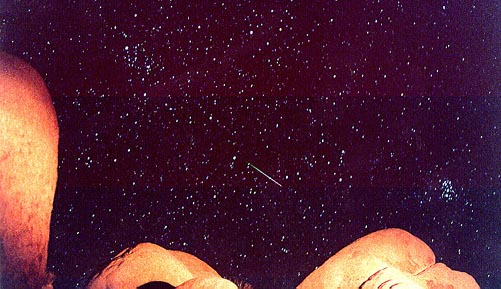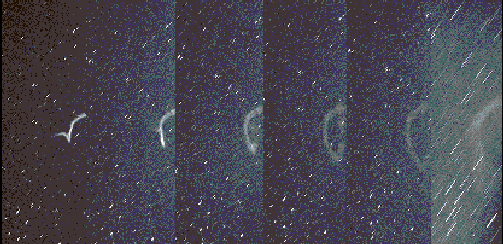| << Previous | Index | Next >> |
2014 Leonids Meteor Shower came to an impressive crescendo in 1999. Observers in Europe saw a sharp peak in the number of meteors visible around 0210 UTC during the early morning hours of November 18. Meteor counts then exceeded 1000 per hour - the minimum needed to define a true meteor storm. At other times and from other locations around the world, observers typically reported respectable rates of between 30 and 100 meteors per hour. This photograph is a 20-minute exposure ending just before the main Leonids peak began. Visible are at least five Leonid meteors streaking high above the Torre de la Guaita, an observation tower used during the 12th century in Girona, Spain. In 2014, over the next few nights, the Leonids meteor shower will again peak. This year, although the crescent Moon should not create much competing skyglow, the Earth is predicted to pass through a more moderate stream of debris left over from Comet Tempel-Tuttle than in 1999, perhaps resulting in as many as 15 visible meteors per hour from dark locations.
2013 Falling through planet Earth's predawn skies toward its close encounter with the Sun on November 28, Comet ISON is coming to life. The much anticipated comet has now been reported to have substantially increased in activity, surging to naked-eye visibility for dark sites and sprouting a more complex tail. ISON's tail stretches over two degrees in this telephoto skyview from southern Kenya, captured on the morning of November 14. Shown in two panels, the enlarged negative version on the right makes details of the long tail easier to trace, including the tail's separated filaments toward the top of the frame. A sungrazer and first time visitor to the inner solar system, the possibility of ISON's survival to become a bright comet in planet Earth's December skies remains a question.
2012 On the morning of November 14, the Moon's umbral shadow tracked across northern Australia before heading into the southern Pacific. Captured from a hilltop some 30 miles west of the outback town of Mount Carbine, Queensland, a series of exposures follows the progress of the total solar eclipse in this dramatic composite image. The sequence begins near the horizon. The Moon steadily encroaches on the reddened face of the Sun, rising as the eclipse progresses. At the total phase, lasting about 2 minutes for that location, an otherwise faint solar corona shimmers around the eclipsed disk. Recorded during totality, the background exposure shows a still sunlit sky near the horizon, just beyond a sky darkened by the shadow of the Moon.
2011 Hot, young stars and cosmic pillars of gas and dust seem to crowd into NGC 7822. At the edge of a giant molecular cloud toward the northern constellation Cepheus, the glowing star forming region lies about 3,000 light-years away. Within the nebula, bright edges and dark shapes are highlighted in this colorful skyscape. The image includes data from narrowband filters, mapping emission from atomic oxygen, hydrogen, and sulfur into blue, green, and red hues. The atomic emission is powered by energetic radiation from the hot stars, whose powerful winds and radiation also sculpt and erode the denser pillar shapes. Stars could still be forming inside the pillars by gravitational collapse, but as the pillars are eroded away, any forming stars will ultimately be cutoff from their reservoir of star stuff. This field spans around 40 light-years at the estimated distance of NGC 7822.
2010 Is this what will become of our Milky Way Galaxy? Perhaps if we collide with the Andromeda Galaxy in a few billion years, it might. Pictured above is NGC 7252, a jumble of stars created by a huge collision between two large galaxies. The collision will take hundreds of millions of years and so is effectively caught frozen in time in the above image. The resulting pandemonium has been dubbed the Atoms-for-Peace galaxy because of its similarity to a cartoon of a large atom. The above image was taken recently by the MPG/ESO 2.2 meter telescope in Chile. NGC 7252 spans about 600,000 light years and lies about 220 million light years away toward the constellation of the Water Bearer (Aquarius). Since the sideways velocity of the Andromeda Galaxy (M31) is presently unknown, no one really knows for sure if the Milky Way will ever collide with M31.
2009
2008 What's happening over the horizon? Although the scene may appear somehow supernatural, nothing more unusual is occurring than a setting Sun and some well placed clouds. Pictured above are anticrepuscular rays. To understand them, start by picturing common crepuscular rays that are seen any time that sunlight pours though scattered clouds. Now although sunlight indeed travels along straight lines, the projections of these lines onto the spherical sky are great circles. Therefore, the crepuscular rays from a setting (or rising) sun will appear to re-converge on the other side of the sky. At the anti-solar point 180 degrees around from the Sun, they are referred to as anticrepuscular rays. Pictured above is a particularly striking set of anticrepuscular rays photographed in 2001 from a moving car just outside of Boulder, Colorado, USA.
2007 This gorgeous image of Orion shows off the constellation's young stars and cosmic clouds of hydrogen gas and dust. Made with a film camera tracking the stars on November 11, the exposure lasted some 40 minutes. It includes the Great Orion Nebula (near center), a string of well-known nebulae leading upwards to Orion's three belt stars, and the large semi-circular arc known as Barnard's Loop that seems to end at the bottom right, next to bluish supergiant star Rigel. Serendipitously, the picture also recorded a bright, comet-shaped cloud not known to share the sky with Orion's famous stars and nebulae. Also spotted by other skywatchers, the mystery cloud was quickly recognized as a fuel dump from a booster rocket used to place a satellite in geosynchronous orbit. Reflecting sunlight, the fuel dump plume begins on the west (right) side of the star field and expands as it slowly drifts eastward and fades during the time exposure, creating the wedge-shaped streak.
2006 For a moment, planets Jupiter, Venus, Mars, and Mercury all posed near their parent star in this Sun-centered view, recorded on November 11. The picture, from a coronograph onboard the space-based SOlar Heliospheric Observatory, spans 15 degrees with the Sun's size and position indicated by the white circle. Background stars are also visible as the otherwise overwhelming sunlight is blocked by the coronograph's occulting disk. But the planets themselves, in particular Jupiter and Venus, are still bright enough to cause significant horizontal streaks in the image. Mercury is actually moving most rapidly (left to right) through the field and days earlier was seen to cross in front of the solar disk. So what's that bright double star to the left of Mars? Zubenelgenubi, of course.
2005 What's that unusual looking spot on asteroid Itokawa? It's the shadow of the robot spacecraft Hayabusa that took the image. Japan's Hayabusa mission arrived at the asteroid in early September and has been imaging and maneuvering around the floating space mountain ever since. The above picture was taken earlier this month. Asteroid Itokawa spans about 300 meters. One scientific goal of the Hayabusa mission is to determine out how much ice, rock and trace elements reside on the asteroid's surface, which should give indications about how asteroids and planets formed in the early Solar System. A can-sized robot MINERVA that was scheduled to hop around the asteroid's surface has not, so far, functioned as hoped. Later this month, Hayabusa is scheduled to descend to asteroid Itokawa and collect surface samples in a return capsule. In December, Hayabusa will fire its rockets toward Earth and drop the return capsule down to Earth's Australian outback in 2007 June.
2004 How old is this galaxy? The nearby Local Group galaxy dubbed the Sagittarius Dwarf Irregular Galaxy (SagDIG) is not only very small but also has relatively few elements more massive than helium. Now the lack of heavy elements might mean that SagDIG is very young, so that component stars had little time to create and disperse massive elements. Conversely, SagDIG's diminutive size could indicate that it formed in the early universe, being a surviving building block of modern large galaxies. The above detailed image from the Hubble Space Telescope has now resolved enough stars to solve this mystery: SagDIG is ancient. Although SagDIG does have some groups of young stars, many stars are very old, and the galaxy as a whole helps astronomers to understand how the universe evolved, and show that at least one metal-poor galaxy is almost as old as the universe. Pictured above, SagDIG spans about 1,500 light years and lies about 3.5 million light years away toward the constellation of Sagittarius.
2003 Is Leo leaking? Leo, the famous sky constellation visible on the left of the above all-sky photograph, appears to be the source of all the meteors seen in 1998's Leonids Meteor Shower. That Leonids point back to Leo is not a surprise - it is the reason that this November meteor shower is called the Leonids. Sand-sized debris expelled from Comet Tempel-Tuttle follows a well-defined orbit about our Sun, and the part of the orbit that approaches Earth is superposed in front of the constellation Leo. Therefore, when Earth crosses this orbit, the radiant point of falling debris appears in Leo. Over 150 meteors can be seen in the above four-hour effort. The Leonids Meteor Shower of 2003 is expected to have two peaks, the first three days ago and the second a long-duration peak covering much of November 19. Although visible meteor rates might approach one per minute, they are predicted to be much less than in the previous few years.
2002 Star trails streak this composite time exposure of comet Tempel-Tuttle recorded by Tim Puckett on January 26, 1998. Then passing through the inner solar system on its 33 year orbit around the Sun, Tempel-Tuttle brightened unexpectedly, but binoculars or small telescopes were still required to visually observe it. Tempel-Tuttle is also called "the Leonid Comet" as the yearly Leonid meteor shower results when the Earth crosses this comet's orbital plane and encounters a trail of cometary dust. So, while not rivaling spectacular naked-eye comets like Hyakutake or Hale-Bopp, Tempel-Tuttle still puts on a show. The Earth is now approaching relatively dense regions of Tempel-Tuttle's orbiting debris trail, so in the next few days, skywatchers will be searching for leonid meteors. An extremely active meteor shower is expected to be visible over Europe and North America in the early morning hours of Tuesday, November 19, despite interference from a glaring full moon.
2001 Will the Leonids storm this year? The annual Leonid meteor shower should peak this weekend and some predictions suggest that "storm" rates of a thousand or more meteors per hour are possible for observers located in eastern North and Central America during the early morning hours of Sunday, November 18. Similar high rates are also anticipated for the western Pacific region on the morning of November 19th. In any event, the 2001 Leonid shower should be dramatic and easy to watch, as were the Leonids of recent years. From top left to bottom right above are spectacular examples of bright fireball meteors from the 1998 Leonid shower as recorded by V. Winter and J. Dudley, Lorenzo Lovato, and Wally Pacholka. A 1998 image from the Puckett Observatory at lower left features the source of the debris stream which supplies the Leonid meteors, comet Tempel-Tuttle.
2000 While stationed in central Africa in December 1944, Norman Appleton witnessed a meteor so bright he remembered it his entire life. Right before his eyes a tremendous smoking fireball streaked across the daytime sky. Years later, as an accomplished member of the Guild of Aviation Artists, he recorded his memories in the above painting. Tonight and tomorrow mark the peak of this year's Leonid meteor shower. Although any individual observer is unlikely to see a fireball as spectacular as this one, observers in dark locations might witness as many as hundreds of transient streaks of light emanating from the constellation of Leo across a morning moonlit sky.
1999 It's not easy to make a map of Antarctica. Earth's southern most continent is so cold and inhospitable that much of it remains unexplored. From space, though, it is possible to map this entire region by radar: by systematically noting how long it takes for radio waves to reflect off the terrain. The Canadian satellite RADARSAT has been orbiting the Earth for the past five years making radar maps, and has recently released the most detailed map of Antarctica ever created. Above is a computer-generated map of Antarctica at relatively low resolution. From the RADARSAT map, scientists have been able to better study this mysterious continent, including information about how ancient ice-shelves are crumbling.
1998 You're in no danger. During the meteor storm occurring tonight and tomorrow, thousands of bits of ice and rock will likely rain onto the Earth. Few, if any, will hit the ground. Touted as potentially the most active meteor shower since 1966, the Leonids of 1998 will be tracked by observers the world over. The meteor storm is caused by the Earth moving through the leftover debris of Comet Temple-Tuttle. The peak of the storm will be best visible tomorrow from Asia, though increased activity should be visible globally over many hours. It is even possible to monitor the storm live on the web. Pictured above is a Perseid 1997 meteor streaking across the sky behind an illuminated California desert.
1997 The Leonid Meteor Shower will likely reach its peak in the early hours this Monday morning. Though the Moon will be bright, Leo, the shower's radiant point, will be well above the eastern horizon from Western North America and the Pacific region during this period. This year's Leonids may prove particularly exciting as observers anticipate the legendary Leonid storm of activity will occur sometime during the next few apparitions of this annual meteor shower - although most expect the meteor storm to occur in 1998 or 1999. Meteor showers result from debris left by passing comets. The Leonids specifically are small pieces of Comet Tempel-Tuttle. In the above series of time-lapse, 1-minute exposures, a 1995 Leonid is seen to leave a train of hot air that glowed persistently for several minutes.
1996 Tonight thousands of icy rocks will hurl toward Earth in a fascinating display of light called the Leonid Meteor Shower. There is little danger - few will reach the ground. But this year's Leonids could be nothing compared to the Leonids in 1998. Then, the Leonids might rival any meteor storm this century, with peak rates possibly toping 40 per second. Meteor showers result from debris left by passing comets. The Leonids specifically are small pieces of Comet Tempel-Tuttle. In the above series of time-lapse, 1-minute exposures, a 1995 Leonid is seen to leave a train of hot air that glowed persistently for several minutes.
1995 The first Hubble Space Telescope (HST) servicing mission, STS-61, was one of the most complicated shuttle missions ever planned. Launched on December 2, 1993 in the Space Shuttle Endeavor, the astronauts were required to make 5 space walks to repair the HST. Astronaut F. Story Musgrave, holding one of the handrails on the HST, is seen here during what became the second longest space walk in NASA history at just under 8 hours. The highly successful mission demonstrated the ability of shuttle astronauts to repair satellites in orbit and allowed the HST to continue to explore the Universe. A future HST servicing mission is planned for 1997.
| << Previous | Index | Next >> |

